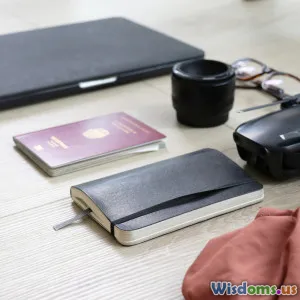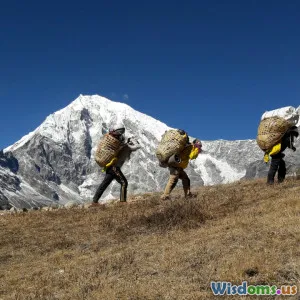
Master the Art of Packing Smart for Adventure Vacations
8 min read Unveil expert strategies to pack efficiently and smartly for adventure vacations, transforming your travel experience with smart gear choices and effective organization. (0 Reviews)
Master the Art of Packing Smart for Adventure Vacations
Introduction
Imagine trekking through a lush rainforest or exploring alpine peaks, strapped with a backpack that's light but packed with everything you truly need. The excitement of an adventure vacation can sometimes be overshadowed by the daunting task of packing. Bringing too much can weigh you down physically and mentally, while packing too little might leave you unprepared for unexpected challenges.
Packing smart for adventure vacations isn't just about fitting everything into a suitcase—it's a strategic, almost artful process that, when mastered, can elevate your entire experience. From selecting multipurpose gear to optimizing your packing sequence, you’ll learn ways to travel better, lighter, and more confidently.
This comprehensive guide not only shares pragmatic tips but uncovers the rationale behind each strategy, empowering you to make savvy packing decisions tailored to your next escapade.
Understand Your Destination and Activities
Before you even think about your suitcase, establish a clear understanding of where you’re headed and what the trip demands.
-
Climate and Weather Considerations: Adventure travel can span climates—from tropical jungles where humidity dominates, to arid deserts with drastic temperature swings, or alpine environments with chill and snow. Research historical weather data and current forecasts. For example, the average humidity in Costa Rican rainforests can surpass 80%, necessitating moisture-wicking fabrics and quick-drying clothing.
-
Activity Specifics: Are you trekking rugged terrains, kayaking rivers, or camping under the stars? Each activity might require specialized equipment. A solo backpacker trekking the Inca trail will prioritize lightweight gear and durable footwear, while a rafting enthusiast must pack waterproof bags and suitable attire.
-
Trip Length and Access: How long you’re away influences quantity and type of items. Also, accessibility to replenishment (markets, rental shops) at your destination affects how much or little you should bring.
Choose the Right Luggage and Packing Tools
Selecting the appropriate bag or case underpins smart packing.
-
Backpack vs. Duffel Bag vs. Suitcase: Backpacks lend themselves to rugged, active trips where mobility matters—think hiking in New Zealand’s South Island. Duffels may offer more capacity but less organization, and suitcases suit urban adventure stays.
-
Size Matters, But So Does Functionality: Aim for a 40–60L capacity for typical adventure trips under two weeks. Excellence in compartmentalization helps keep items organized and accessible.
-
Packing Cubes and Compression Bags: Utilizing packing cubes enables modular organization, while compression bags reduce bulk especially for soft clothing and sleeping bags. For instance, compression can save up to 50% volume, critical on space-limited journeys.
Prioritize Multipurpose and Lightweight Gear
Reducing weight without sacrificing essentials is key.
-
Invest in Versatile Clothing: Choose items convertible for multiple uses (e.g., pants with detachable legs turning into shorts). Fabrics like merino wool are antimicrobial, suitable for extended wear without frequent washing.
-
Multi-functional Equipment: Examples include a Swiss Army knife, headlamps with adjustable beams, or trekking poles that collapse and serve as tent supports.
-
Minimize Duplicates: If your sleeping bag can serve as a blanket, or your jacket also touches quarrying water resistance and insulation, focus on those to save space.
Master the Art of Efficient Folding and Packing Techniques
How you pack can be just as important as what you pack.
-
Rolling vs. Folding: Rolling clothes usually saves space and reduces wrinkles. However, stiffer items like jackets sometimes fare better folded.
-
Stuffing Small Items Strategically: Fill shoes with socks, chargers, or other small packets to maximize every inch.
-
Weight Distribution: Place heavier items near the center or bottom of your backpack for balance and comfort. A poorly balanced bag can cause fatigue and injury.
Prepare for Unpredictability with Smart Essentials
Adventure travel can be unpredictable; proper preparation is your safety net.
-
First Aid and Emergency Supplies: Pack a compact, customized first aid kit. According to the Wilderness Medical Society, most minor hiking injuries can be addressed with basics like bandages, antiseptics, and pain relief medication.
-
Navigation Aids: Despite smartphones, bring offline maps, compasses, or GPS devices. For example, the Garmin inReach Mini offers satellite communication, critical in remote areas.
-
Weather-Specific Gear: Include rain ponchos, thermal layers, or sun protection—items that may seem bulky but can make a big difference.
Consider Technology and Power Needs
-
Minimalist Electronics: Opt for lightweight gear with multiple functions, such as a smartphone for photos, GPS, and entertainment.
-
Power Banks and Solar Chargers: When off-grid power access is limited, high-capacity battery packs or solar panels ensure devices stay charged.
-
Adapters and Cables: Only bring necessary charging cables. Universal adapters are particularly useful in international travel.
Practical Tips from Experienced Travelers
-
Leave Useless Items Behind: Travel blogger Matt Karsten advises, "If you haven’t used it in the last three trips, reconsider bringing it." This less-is-more mindset prevents overpacking.
-
Test Your Packed Bag: Walk or hike a few miles with your packed setup before departure. This helps identify discomforts or unnecessary items.
-
Layer Your Capacity: Use a daypack for daily excursions, keeping your main pack organized and your mobility high.
Conclusion
Packing smart for adventure vacations is about intentionality, knowledge, and a bit of creativity. By aligning your packing strategy with your destination’s demands, focusing on versatile gear, mastering packing methods, and preparing for the unforeseen, you maximize comfort and enjoyment.
Adventure awaits — don’t let your luggage weigh you down. Optimize every stitch, item, and ounce of your kit, and embark without hesitation. Your best journey yet begins with a smart pack.
References:
- Wilderness Medical Society Guidelines
- National Climatic Data Center for climate statistics
- Adventure travel blogs by Matt Karsten and Noraly Schoenmaker
- Garmin product specs and reviews
Ready to revolutionize your packing game? Start planning your ultimate adventure kit today!
Rate the Post
User Reviews
Popular Posts


















